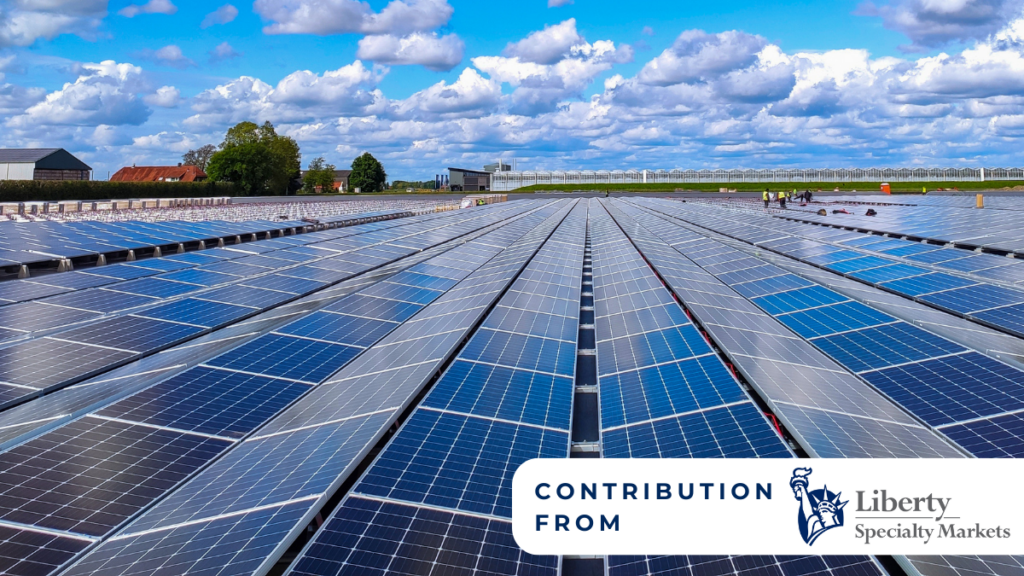A review of the renewable and traditional energy sector and the associated risks
This article, written by Sara Sampaio Soares, Liberty Specialty Markets, provides insights into the issues faced by the renewable energy sector, and the various aspects that the insurance industry needs to consider.
Sara Sampaio Soares, Liberty Specialty Markets

What are the key insurance risks and issues at present for the renewable energy sector?
Weather and Natural Catastrophe (NAT CAT) risks are at the forefront of the insurance industry as a whole, and it’s a concern the renewable energy sector is familiar with. Our Global claims experience has shown us that the frequency and severity of CAT losses affecting the renewable energy sector is on the rise, and Australia has been no exception. Given the physical nature and characteristics of solar and wind projects, these assets can be easily exposed to such perils. In Australia, we are predominantly affected by floods and windstorms, and then there are theso-called secondary perils of hail, bushfire and lightning.
A growing concern for the industry is the risk of sub-par contractor selection. Industry losses due to contractor error or poor workmanship have resulted in an increase in our scrutiny of contractor and subcontractor arrangements. While we’ve not necessarily been hit with highly technical workmanship claims, even relatively straight forward incidents, replicated across multiple sites and at scale, are generating very high value losses for the industry.
With international organisations, it’s important to understand the experience of the local Australian team. To ensure that the team performing the work understands Australian conditions, and also has the necessary training and capabilities to manage such projects.
Investment over the last 8 years, approximately, into the Australian renewable energy sector has been tremendous and we have seen the latest technology and equipment for wind and solar PV farms deployed across new projects. Whilst output maximisation is the ultimate goal for project owners, deploying the latest or largest technology and / or equipment can bring added challenges to a project, evidenced in the significant number of machinery breakdown losses the industry has sustained. An example of this is the availability of specialist cranes for erecting or repairing wind turbines.From an insurance perspective, we need to ensure that we are informed of and comfortable with the latest technological developments and the added complexities that they could bring.
Because of the unpredictability of renewable energy sources, managing the peaks and troughs of generation can be difficult and Battery Energy Storage Systems (BESS) have been able to help smooth out these rapid load variations, as well as being beneficial for overall grid stability. There are now various large BESS projects in operation or in development around Australia, however this technology does bring added risks and challenges that must be managed. Fire is one such risk. The industry has already sustained various BESS fire related losses. It has become evident that developers must ensure the BESS design configurations include fire protection, and that loss mitigation of these assets is duly considered.
According to an expert independent risk management and design certification body on BESS technology, over the life of a battery operation, it can be expected that it will be impacted by at least one fire. The potential for thermal runaway is also significant and given the amount of stored energy this means traditional gaseous suppression systems are not effective. Underwriters are
therefore looking for reassurance around any operation’s fire mitigation strategies, as well as spacing and real-scale fire tests.
What are the key risks and issues for traditional energy?
As the world decarbonises and investment moves towards green, renewable energy sources, it is important that traditional energy players continue to deploy adequate resources to their operating plant and equipment in a safe and responsible way.
What are the things brokers should be aware of / questions they should be asking when working with businesses in the energy sector?
The more information we receive detailing a client’s operations the better the insurance outcome for the client. We need to understand the true exposures affecting a client’s business and how well they manage these.
Comments are focused on large-scale ground-mounted Solar PV and Onshore Wind Farms in Australia.